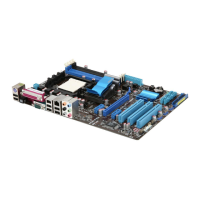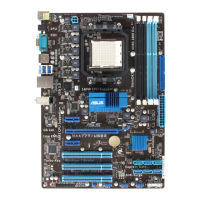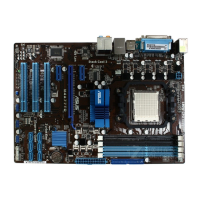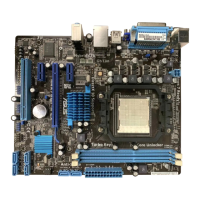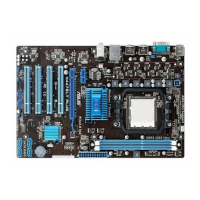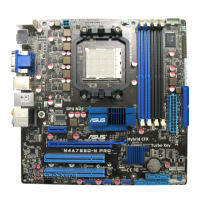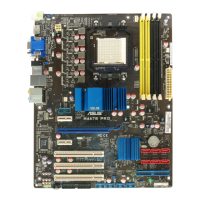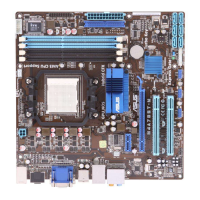Do you have a question about the Asus M4A77T and is the answer not in the manual?
Covers electrical shock prevention and safe handling of components during operation.
Explains manual symbols, typography, and where to find additional product information.
Welcomes the user and lists all items included in the motherboard package.
Highlights the special features and technologies of the ASUS M4A77T motherboard.
Essential safety warnings and guidelines before handling or installing motherboard components.
Instructions on correct motherboard orientation, mounting points, and securing methods.
Details the layout and location of all connectors, slots, and jumpers on the motherboard.
Step-by-step guide for safely installing the CPU into its socket.
Instructions for mounting the CPU heatsink and fan for effective thermal management.
Procedures for installing and removing DDR3 memory modules into the motherboard slots.
Guides on inserting expansion cards and adjusting settings via BIOS and drivers.
Explains how to clear CMOS settings and use the MemOK! switch for memory issues.
Details all rear panel ports and internal connectors for system components and peripherals.
Guidance on OS installation and utilizing the included Support DVD for drivers and utilities.
Covers methods for updating the BIOS using ASUS utilities like EZ Flash and CrashFree.
Instructions on accessing the BIOS and understanding its interface, menus, and navigation.
Displays system details, storage configuration, and allows time/date settings.
Advanced options for CPU overclocking, chipset features, memory timings, and onboard device configuration.
Settings for ACPI, suspend modes, power loss restore, boot order, and security.
Access to utilities like EZ Flash, saving changes, and exiting the BIOS setup.
Covers electrical shock prevention and safe handling of components during operation.
Explains manual symbols, typography, and where to find additional product information.
Welcomes the user and lists all items included in the motherboard package.
Highlights the special features and technologies of the ASUS M4A77T motherboard.
Essential safety warnings and guidelines before handling or installing motherboard components.
Instructions on correct motherboard orientation, mounting points, and securing methods.
Details the layout and location of all connectors, slots, and jumpers on the motherboard.
Step-by-step guide for safely installing the CPU into its socket.
Instructions for mounting the CPU heatsink and fan for effective thermal management.
Procedures for installing and removing DDR3 memory modules into the motherboard slots.
Guides on inserting expansion cards and adjusting settings via BIOS and drivers.
Explains how to clear CMOS settings and use the MemOK! switch for memory issues.
Details all rear panel ports and internal connectors for system components and peripherals.
Guidance on OS installation and utilizing the included Support DVD for drivers and utilities.
Covers methods for updating the BIOS using ASUS utilities like EZ Flash and CrashFree.
Instructions on accessing the BIOS and understanding its interface, menus, and navigation.
Displays system details, storage configuration, and allows time/date settings.
Advanced options for CPU overclocking, chipset features, memory timings, and onboard device configuration.
Settings for ACPI, suspend modes, power loss restore, boot order, and security.
Access to utilities like EZ Flash, saving changes, and exiting the BIOS setup.
| ECC | Yes |
|---|---|
| Number of memory slots | 4 |
| Maximum internal memory | 16 GB |
| Processor socket | Socket AM3 |
| Processor manufacturer | AMD |
| Maximum number of SMP processors | 1 |
| Number of SATA connectors | 6 |
| Headphone outputs | 3 |
| USB 2.0 ports quantity | USB 2.0 ports have a data transmission speed of 480 Mbps, and are backwards compatible with USB 1.1 ports. You can connect all kinds of peripheral devices to them. |
| Firewire (IEEE 1394) ports | 0 |
| Motherboard chipset | AMD 770 |
| Motherboard form factor | ATX |
| PCI Express x1 slots | 2 |
| Controller 2nd interface type | IDE/SATA |
| LAN controller | Realtek RTL8112L |
| ACPI version | 2.0 |
| BIOS memory size | 64 Mbit |
| Depth | 213 mm |
|---|---|
| Width | 305 mm |

